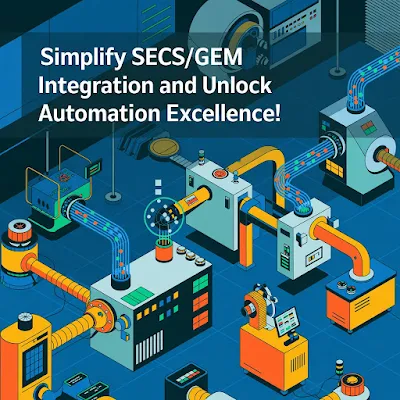The rise of the Internet of Things (IoT) has ushered in a new era of connectivity and real-time intelligence across industries. In semiconductor manufacturing and other precision-driven fields, the challenge lies in synchronizing IoT smart devices with existing factory automation frameworks. That’s where the SECS/GEM protocol plays a pivotal role. By enabling standardized communication between equipment and host systems, SECS GEM creates a bridge between modern IoT architectures and traditional manufacturing environments.
This blog explores how integrating SECS/GEM interface technologies with IoT can unlock smarter, more agile, and fully automated factory ecosystems.
The Intersection of IoT and Factory Automation
Factory automation thrives on repeatability, standardization, and efficiency—qualities that make SECS/GEM Software a natural fit. Designed to facilitate real-time data exchange, status reporting, and command control, SECS GEM protocols enable direct communication between tools and the factory host. But until recently, its integration with IoT technologies was limited.
Today’s smart devices—from sensors and cameras to AI-powered machine vision systems—generate massive volumes of actionable data. Without a bridge like the SECS/GEM communication protocol, much of this data remains siloed or underutilized in high-value environments such as wafer fabs and PCB assembly lines.
Through strategic SECS/GEM integration, smart IoT devices can now seamlessly interact with factory systems to:
- Enable predictive maintenance through cloud-based analytics.
- Share granular real-time status updates.
- Support dynamic production reconfiguration based on equipment health and output.
- How SECS/GEM Integration Unlocks Smart Manufacturing
The core strength of SECS/GEM lies in its ability to standardize equipment behavior across diverse platforms. When combined with IoT infrastructure, this yields a digitally agile environment where machine learning models, cloud dashboards, and smart sensors are orchestrated in unison.
Key Benefits of IoT and SECS/GEM Integration:
Unified Monitoring: Integrating SECS/GEM Software with IoT devices creates a single data stream for monitoring equipment performance and environmental variables like temperature, vibration, and humidity.
Automated Responses: Through SECS GEM communication, smart devices can trigger automated shutdowns, tool calibrations, or supply requests when anomalies are detected.
Scalability: As operations scale, SECS/GEM interface ensures consistent equipment behavior even as new IoT devices or platforms are introduced.
Cloud-Based Insights: SECS/GEM integration with cloud platforms lets manufacturers apply advanced analytics, AI, and digital twins to optimize factory operations.
Consider a production line where smart IoT sensors continuously monitor vibration levels in critical tools. By feeding this data through the SECS GEM interface, the host system can initiate just-in-time maintenance—improving uptime and extending equipment life.
Overcoming Integration Challenges
While the potential is vast, integrating SECS/GEM communication with IoT systems is not without hurdles. Legacy systems may lack native IoT compatibility, and protocol translation is often required. This is where tools like EIGEMBox come into play, serving as middleware that enables plug-and-play SECS/GEM protocol support for equipment previously isolated from modern networks.
Successful SECS/GEM integration with IoT depends on:
- Middleware solutions that convert non-standard inputs into recognized GEM commands.
- Secure APIs and cloud gateways to funnel IoT data into centralized systems.
- Adherence to GEM compliance standards, ensuring compatibility across vendors.
As factories evolve toward Industry 4.0, the synergy between IoT and SECS GEM becomes a strategic advantage. By bridging smart devices with factory automation systems through the SECS/GEM communication protocol, manufacturers gain more visibility, control, and responsiveness than ever before.
Whether you’re modernizing legacy equipment or designing a next-gen fab, SECS/GEM Software and IoT hold the keys to a smarter, more integrated production floor. The result? Improved efficiency, minimized downtime, and a future-ready approach to manufacturing.


